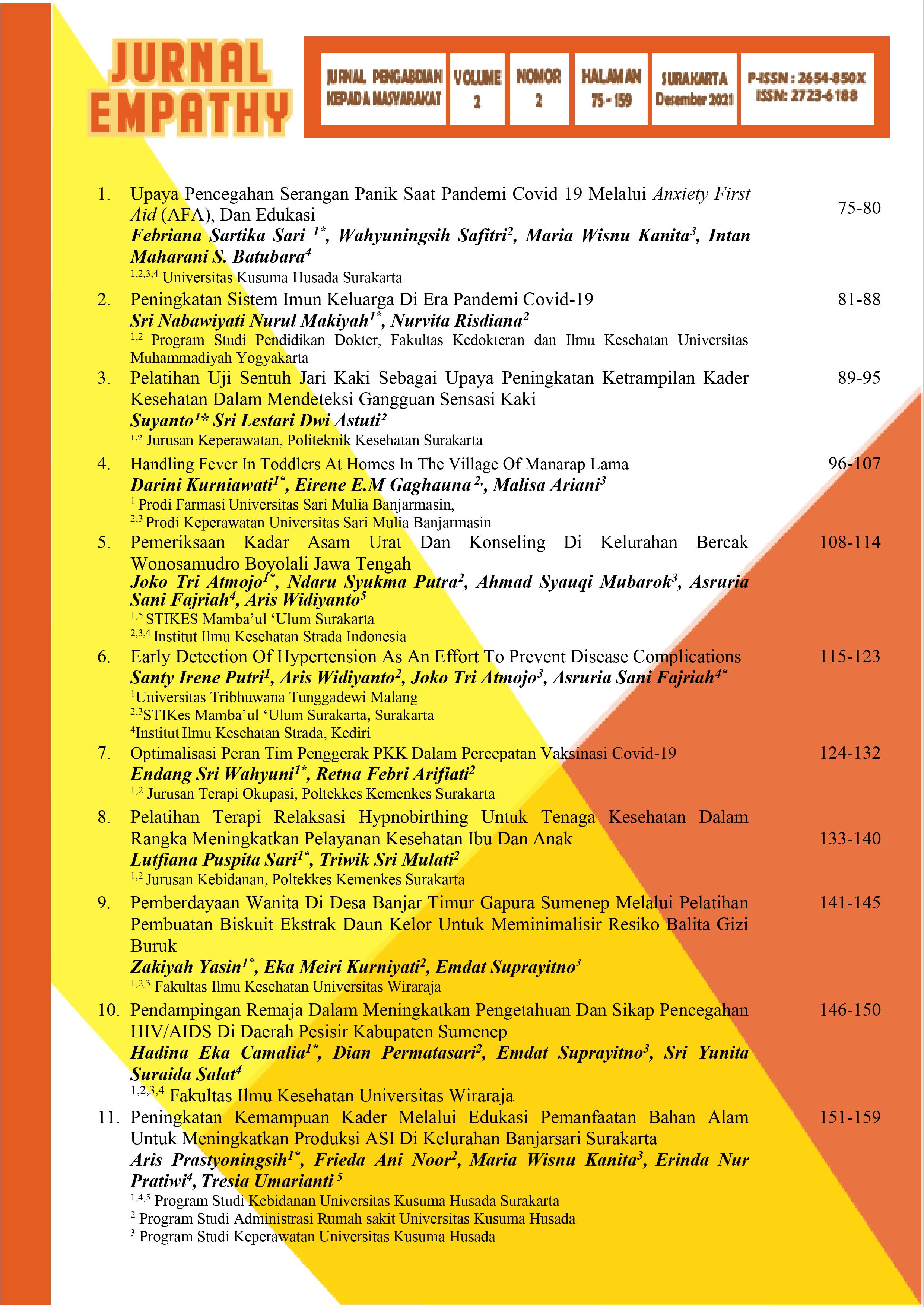Upaya Pencegahan Serangan Panik Saat Pandemi Covid 19 Melalui Anxiety First Aid (AFA), Dan Edukasi
Main Article Content
Abstract
Background: The pandemic of COVID 19 has impact on many field include mental health. People experience fear, anxiety, and even panic attacks. Anxiety will cause many negative effects. Handling anxiety quickly can be done by providing Anxiety First Aid . The purpose of the research is to increase the citizen level of knowledge and skill about Anxiety First Aid and adaptive coping in COVID 19 pandemic. Methods: Activities carried out by three main activities such as screening of panic incident, providing Anxiety First Aid (AFA) training, and education about adaptive coping. Respondents involved were 21 residents of Bonoroto Plesungan Karanganyar Central Java. Results: There is a resident who has panic incident history. The knowledge and skill of residents increase after giving training and education. The pre-test showed that the majority of the respondents had bad knowledge (90,47% or 19 respondents) and bad skill (100% or 21 respondents). The post-test showed that the majority of the respondents had good knowledge (86% or 18 respondents) and good skill (86% or 18 respondents). Conclusion: Adaptive coping and Anxiety First Aid are highly recommended to prevent panic attacks during COVID 19 pandemic.
Article Details
How to Cite
References
Ahmad, A. R., & Murad, H. R. (2020). The impact of social media on panic during the COVID-19 pandemic in iraqi kurdistan: Online questionnaire study. Journal of Medical Internet Research, 22(5). https://doi.org/10.2196/19556
Borges Machado, D., Alves, F. J., Teixeira, C. S., Rocha, A. S., Castro-de-Araujo, L. F., Singh, A., & Barreto, M. L. (2020). Effects of COVID-19 on Anxiety, Depression and Other Mental Health Issues: A worldwide scope review. In Research Square. https://doi.org/10.21203/rs.3.rs-58186/v1
Guan, J., Wu, C., Wei, D., Xu, Q., Wang, J., Lin, H., Wang, C., & Mao, Z. (2021). Prevalence and factors for anxiety during the COVID-19 pandemic among college students in China. International Journal of Environmental Research and Public Health, 18(9). https://doi.org/10.3390/ijerph18094974
Hapter, C., Rch, J. O. A., & Raske, M. I. G. C. (2008). Arch J, Craske, MJ. Panic disorder: In W.E. Craighead, D.J. Miklowitz, & L.W. Craighead (Eds.),Chapter 4, Psychopathology: history, diagnosis, and empirical foundations. New York: Wiley. 1–64.
Harris, S. J. (n.d.). “The time to relax is when you don’t have time for it.”
Li, Y., Id, N. S., Id, L. F., & Kuper, H. (2021). Prevalence of depression , anxiety and post- traumatic stress disorder in health care workers during the COVID-19 pandemic : A systematic review and meta-analysis. 1–19. https://doi.org/10.1371/journal.pone.0246454
Liang, L., Ren, H., Cao, R., Hu, Y., Qin, Z., & Li, C. (2020). Liang2020_Article_TheEffectOfCOVID-19OnYouthMent.pdf. 1163, 841–852.
Nicomedes, C. J. C., & Avila, R. M. A. (2020). An analysis on the panic during COVID-19 pandemic through an online form. Journal of Affective Disorders, 276, 14–22. https://doi.org/https://doi.org/10.1016/j.jad.2020.06.046
Noor, Z., & Junaidi. (2010). Penurunan Tingkat Kecemasan Pada Lansia Melalui Terapi Musik Langgam Jawa. Jurnal Keperawatan Indonesia, 13(3), 195–201.
Ozamiz-Etxebarria, N., Santa María, M. D., Munitis, A. E., & Gorrotxategi, M. P. (2020). Reduction of COVID-19 Anxiety Levels Through Relaxation Techniques: A Study Carried Out in Northern Spain on a Sample of Young University Students. Frontiers in Psychology, 11(August), 1–6. https://doi.org/10.3389/fpsyg.2020.02038
Sari, F., Kartina, I., Batubara, I., & Mariyati, M. (2020). Anxiety First Aid Effective to Reduce Adolescent’ Anxiety. Indonesian Journal of Global Health Research, 2(4), 327-334. https://doi.org/10.37287/ijghr.v2i4.237
Sellakumar, G. K. (2015). Effect of slow-deep breathing exercise to reduce anxiety among adolescent school students in a selected higher secondary school in Coimbatore, India. Journal of Psychological and Educational Research, 23(1), 54–72.
Songwathana, P. (2011). Spirituality Intervention and Outcomes: Corner stone of Holistic Nursing Practice. Nurse Media: Journal of Nursing, 1(1), 117–127. https://doi.org/10.14710/nmjn.v1i1.751
Sulistyawati, R., Probosuseno, & Setiyarini, S. (2019). Dhikr Therapy for Reducing Anxiety in Cancer Patients. Asia-Pacific Journal of Oncology Nursing, 6(4), 411–416. https://doi.org/10.4103/apjon.apjon_33_19
Suwandi, G. R., & Malinti, E. (2020). Hubungan Tingkat Pengetahuan Dengan Tingkat Kecemasan Terhadap Covid-19 Pada Remaja Di SMA Advent Balikpapan. Malahayati Nursing Journal, 2(4), 677–685. https://doi.org/10.33024/manuju.v2i4.2991
WHO. (2016). Nordic statistics on acute hepatic porphyria: ICD-10 report. October 2019. 3.
WHO Indonesia. (2020). Penyakit Coronavirus 2019 (COVID-19) Mei. World Health Organization, 19, 1–20. https://covid19.who.int/
Yorkers, N. (n.d.). Anxiety and Panic Attacks During COVID-19.

